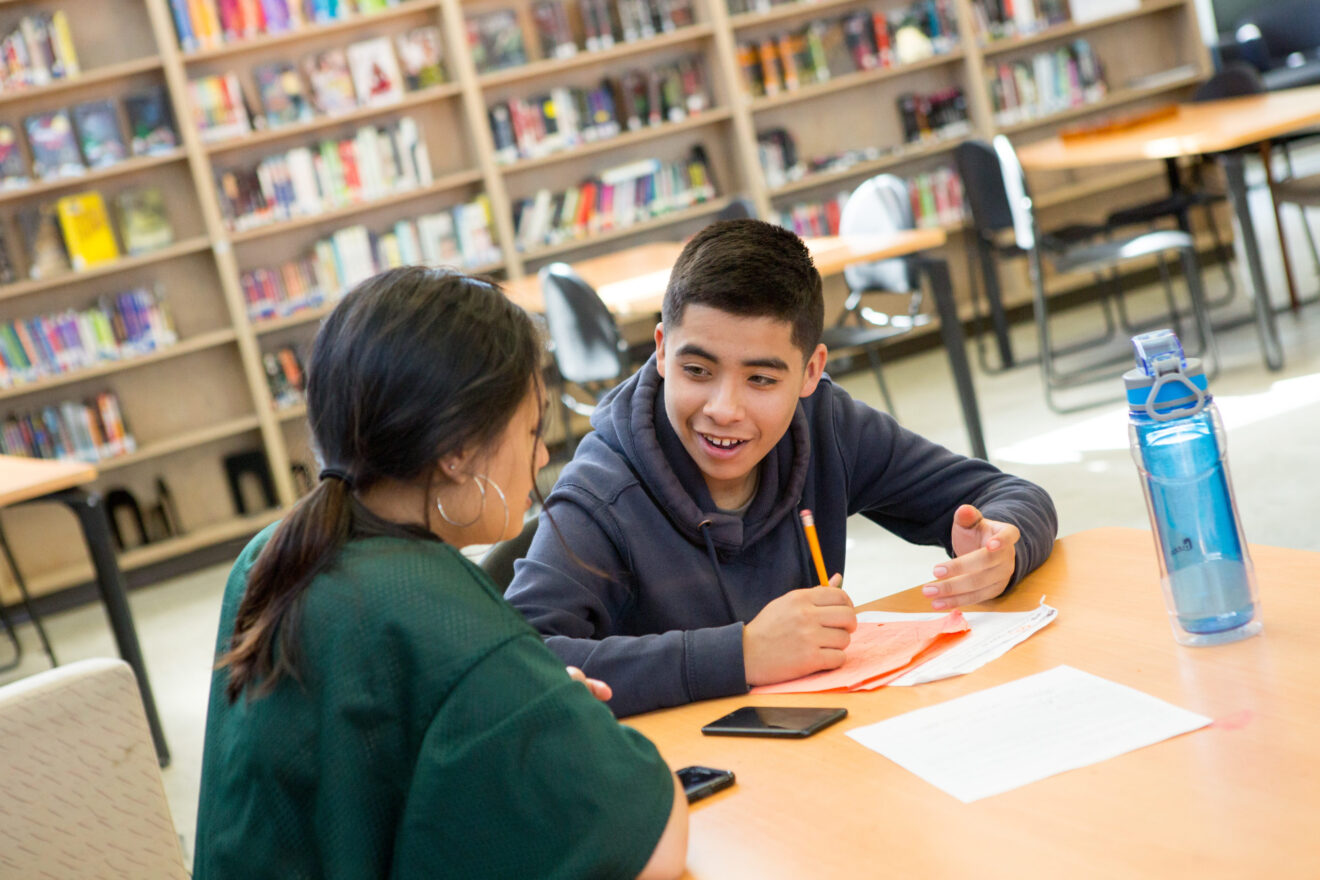In most schools today, there’s a harsh reality: Students’ access to social capital — relationships and the array of resources they can offer — is inherently limited by their campus’ human capital: the employees on schools’ payroll. School-based relationships are critical sources of student support. But tight budgets spell small support networks.

This is especially true when it comes to helping students navigate transitions to postsecondary education and work. Nationally, high-school student-to-counselor ratios remain over 400-to-1. In colleges, career services offices fare even worse, with an alarming one career services professional to 2,263 students.
Numbers like these hardly leave room for relationship-rich guidance to help young people make high-stakes decisions about their college and career options.
How can schools extend both the number and reach of guidance relationships at students’ disposal? While some turn to seasoned staff and volunteers, that misses a plentiful resource hiding in plain sight: near peers — those close in age and experience to their fellow students, and often still students themselves.
Near peers are a proven source of advice and inspiration for young people. In a recent Search Institute study of programs helping students from low-income households secure upwardly-mobile jobs, near peers emerged as the strongest developmental relationship (compared with direct peers and program staff). They provided program participants with the most resources, such as valuable information, connections to employers and professional skills.
At the same time, training near peers to support their fellow students offers a compelling intervention in its own right: It’s an efficient way to further invest in those students’ leadership skills and support networks, even after they advance beyond a given class or program.
That all sounds good in theory. But building an effective near-peer coaching program hinges on schools’ understanding of how to recruit and train their current students and alumni to pivot from receiving help to providing it.
We’ve gathered key lessons that champions of peer coaching have learned.
1. Shrink ratios, grow redundancy
One of the biggest benefits of near-peer models is cost. According to one study by MENTOR, near peers are the cheapest mentoring program model, averaging $1,170 per year per youth. Another program, College Access: Research & Action, which works with New York high schools to train peer leaders to support college guidance, nets out for schools at $250 per student served, with the other half of costs covered by philanthropy.
Those savings mean more students have more people helping them navigate school and work. For example, CARA partners with schools to create Right to College programming, which employs 11th- and 12th-graders to work in their own schools, and College Bridge programming, which employs college students to work in high schools, often at their alma mater. Most schools partnered with CARA employ one to four peer leaders, making a dramatic dent in their counselor-to-student ratios. Last year, the overall counselor-to-student ratio at their partner schools, including both adult and peer leaders as counselors, (proportional to the hours they work) was 1-to-65.
Better economics can also spell rapid growth where traditional staffing falls short. For example, the national nonprofit COOP, which helps low-income, first-generation college graduates find jobs in the technology sector, is largely staffed by program alumni who serve as part-time, paid coaches. For the past five years, COOP managed to grow 35% to 50% year over year by recruiting one in every 10 program alumni to return as a coach.
That recruitment engine affords the program high-touch ratios. COOP places participants into cohorts of 16, coached by four alumni captains. One of those four is a senior captain who has coached before.
COOP has also found that group-based coaching generates even more resources for participants. Each cohort of 16 participants has access to all four captains, with one captain primarily responsible for four participants. That approach creates what COOP’s founder, Kalani Leifer, dubs “redundancy.” Cohort members can turn to any of the four coaches for different types of support.
“I don’t think I’d want mini cohorts of 1-to-4,” Leifer says. “There’s not enough redundancy created. Redundancy makes a community and its members more resilient, less reliant on single points of failure (or flakiness).”
Access to the more plentiful support and guidance these programs can offer pays off. On average, COOP participants have secured jobs that pay $50,000 within 12 months of completing the program. And postsecondary enrollment among students in CARA’s Right to College programs grew 22 percentage points in four years.
2. Redefine — and reward — expertise
Beyond ratios and cost savings, these models have an even more compelling upside: the unique expertise that students themselves possess.
To be clear, that expertise must be nurtured. Plentiful research shows that effective near-peer programs depend on training and supervision. Training can be extensive: CARA provides peer leaders with 70 hours of training and supports their professional learning through evaluation on a range of guidance and professional competencies. COOP’s captains engage in 35 hours of training.
Even with these investments, programs shouldn’t expect current students or recent grads to possess all of the knowledge and skills that guidance professionals do. But they can expect the credibility and real-time knowledge those more seasoned professionals might lack. For COOP, captains are especially powerful guides for navigating turbulent labor markets in tech.
“Managing expectations isn’t lowering expectations,” Leifer explained. “It’s not only that captains gathered enough of the wisdom. … It’s that they have a unique and time-sensitive set of wisdom to share with the next group.”
In CARA’s case, near peers can offer insider knowledge of the byzantine college application process, which shifts as policies and institutions evolve.
“They know how the process changed more than a teacher who did it 10 years before,” explained Janice Bloom, co-founder and co-director of CARA. That credibility can also spur more students to seek out support. “Some young people who wouldn’t come into guidance offices now come in and want to talk to the peer leader,” Bloom says.
Honoring near peers’ time and expertise means that schools should expect to pay them for it. In CARA’s case, peer leaders are compensated by schools at New York’s minimum hourly wage. At COOP, captains earn approximately $3,000 per semester of coaching.
Notably, some research suggests that when peer coaches and mentors are compensated may matter. In its research and guidance on building effective K-12 peer mentoring programs, MENTOR found that if peer mentors are compensated too early in the process (i.e., solely during training), they may not be incentivized to show up for the entirety of the program.
3. Integrate peers into school operations
Are institutions taking a page from nonprofits like CARA and COOP, investing in their own students as coaches to guide those that come after them? Slim data suggests not. According to MENTOR’s 2017 scan across in- and out-of-school mentoring programs nationally, only 7% were peer or near-peer models.
Peer and near-peer models may be especially rare as core to schools’ operating models rather than one-off programs or clubs. That’s a testament to both mindsets and capacity constraints.
“It’s hard to get the school system to take their own young people seriously in professional roles,” Bloom says.
But for Bloom and her team, even once schools buy into the model, they still need support. In other words, the very capacity constraints that make peer-to-peer programming appealing can make it hard to get off the ground.
“With the peer leadership, we don’t think individual schools will ever have the capacity to provide 70 hours of training because counselors are deluged already,” she says.
Still, leaders like Bloom and Leifer believe high schools and colleges can start to fit models like theirs into core operations. Take CARA’s decision to have schools compensate peer leaders themselves: “We do that purposely because we want schools to have skin in the game,” Bloom explained. “We want schools to start building into their budget having alumni on the staff.”
Similarly, Leifer sees postsecondary career services starting to come around to alumni-powered guidance models.
“In the years ahead, we think our method — peer cohorts, alumni coaches and a focus on full-time jobs — could be even more efficient and effective when embedded in these institutions and their strategic goals. By mobilizing alumni in the 12 months around graduation, colleges could dramatically improve career outcomes for first-gen and low-income grads,” Leifer says.
For those wary of ceding too much power or resources to young people, changing schools’ operating model doesn’t mean abandoning structures.
“Institutions need hierarchies. To do good things, we need to be organized. You can’t have middle-schoolers running the middle school. But that doesn’t mean they can’t have important, high-impact, downward-facing roles,” Leifer says.
In fact, he argues that providing students with leadership roles is an especially important way to channel agency without upending structure: “If there’s someone more junior to lead, students don’t have to push all their energy and ideas upward in order to make a real impact on their environment.”
That sums up what’s perhaps most exciting about models like CARA and COOP: deploying peers and recent alumni not merely as a staffing strategy, but as a strategy to ensure that their students are surrounded by broader networks of support and opportunity to find their way. Peer models invest in students’ social capital as a renewable resource rather than a sunk cost, across a campus. Altogether, that’s an important shift for education reformers of all stripes to consider when deeming high-touch interventions as hard to scale. With the will and these insights to help guide their way, schools could unlock the far-reaching impact of near peers.
Julia Freeland Fisher is the director of education research at the Clayton Christensen Institute. Her work aims to help policymakers and education and community leaders harness the power of disruptive innovation in the K-12 and higher education spheres. She’s also the author of “Who You Know: Unlocking Innovations That Expand Students’ Networks.”
Opinions expressed by SmartBrief contributors are their own.
_________________________
Subscribe to SmartBrief’s FREE email ASCD newsletter to see the latest hot topics in education. It’s among SmartBrief’s more than 250 industry-focused newsletters.
